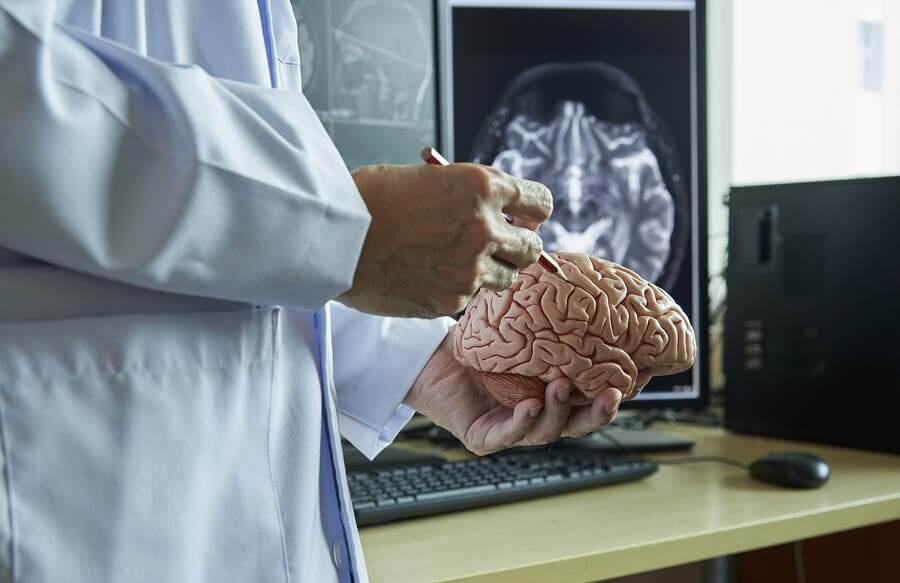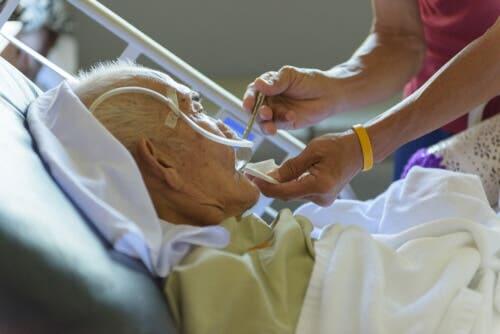Vegetative State: Everything You Need to Know


Written and verified by the doctor Leonardo Biolatto
Many alterations can affect a person’s level of consciousness. Vegetative states occupy a prominent place in this broad topic. Formerly, a vegetative state was used to refer to unconscious patients whose vital functions were generally substituted.
It wasn’t until the 1970s when two renowned neurologists, Brian Jennet and Freud Plum, scientifically described the condition. Since then, experts have published multiple articles where they analyze the vegetative state from different angles. In fact, some controversies are still under discussion.
In this article, we’ll explain the most important aspects that you should know about the vegetative state.
What’s the vegetative state?
To better explain it, we’re going to divide the brain into two parts, depending on what they control:
- The cerebral hemispheres control thoughts and behaviors, making us aware of ourselves and our environment. In them, we find the different lobes, frontal, temporal, occipital, and parietal, with their respective functions, performed by the neurons that are in the cortex of the hemispheres.
- The diencephalon, which consists of the thalamus and hypothalamus, and the brainstem control vital functions. These include sleep-wake cycles, body temperature, breathing, blood pressure, and heart rate, among others. This part of the brain is our primitive brain.

Continue reading: 12 Ways to Stimulate Your Child’s Brain Health
A vegetative state is a long-lasting disorder that occurs when the brain hemispheres stop working. Therefore, the person ceases to be aware of themselves and the environment. However, the most primitive brain, which continues its vital functions, isn’t affected.
“A persistent vegetative state is a complex neurological condition in which patients appear to be awake but show no sign of awareness of themselves or their environment.” -Monti et al., 2010
The causes of a vegetative state
There are several causes of vegetative state since any disorder that leads to brain damage can cause it.
Normally, it occurs because the function of the brainstem and diencephalon resume after a causal agent, but the same doesn’t occur with the function of the cerebral cortex or cortical function.
The most common causes are:
- Head trauma, like a helmetless biker who receives head damage in an accident
- A disorder that deprives the brain of oxygen, such as cardiac arrest or respiratory arrest.
- Cerebrovascular disease, like a brain artery that doesn’t allow blood to reach the brain, leading to a stroke
Other causes can be tumors, hemorrhages, brain infections, and the final stages of dementia, such as Alzheimer’s, among others. These disorders don’t harm the primitive brain, but they do damage the cerebral cortex.
This article may interest you: What Are the Different Lobes of the Brain?
Vegetative state symptoms
People in a vegetative state can do some things that can make you believe that they’re aware, such as:
- Open their eyes. The patient can alternate sleeping times with their eyes closed with periods in which they keep their eyes open.
- They can breathe, suck, chew, cough, gag, swallow, and make sounds, among others.
- They can even react to strong stimuli, such as big noses, and sometimes seem to smile or frown.
However, the primitive brain carries out these reactions without any awareness. They’re the result of basic involuntary reflexes that all humans have.
How can doctors know that they’re not conscious?
To determine if someone is conscious, there must be intention in their actions. This intention indicates that they’re relating to their external environment:
- Although the patient can open and close their eyes and perform eye movements, they have no purpose. The movements are random and independent of the stimuli. For example, if the patient has their eyes open and you put a pencil in front of them, they won’t follow it with their eyes if you move it.
- The patient doesn’t make any voluntary or intentional motor movement. If they make a gesture or lift a limb, it’s because they’re reacting to intense stimuli. For example, they can be awakening and startle reflexes, due to loud noises. The rest of the movements are primitive reflexes, such as sucking, chewing, and swallowing, among others.
- They can’t speak and don’t utter a word. If the patient makes any noise, it’ll be grunts or primitive noises.
- If they’re given a verbal or written order, they won’t follow it or react to it.
- The patient has fecal and urinary incontinence.
Therefore, the patient isn’t aware of anything but their heart and lungs continue to function. In other words, they can maintain their blood pressure and cardiorespiratory functions.

Diagnosis
Diagnosis is based on a medical professional’s evaluation of the symptoms. Although the patient has all the symptoms of vegetative state, medical professionals must observe the patient for a while to confirm this state. If not, certain signs of consciousness may be overlooked.
Imaging tests can help discover which part of the brain has been affected and see if it can be treated. To see if there’s any kind of consciousness, doctors resort to tests such as functional magnetic resonance imaging (fMRI) or electroencephalogram (EEG).
Unfortunately, these tests can’t detect the patient’s level of consciousness. They only detect if there’s consciousness that can’t be determined with the naked eye. These results may affect decisions about long-term care and the possibility or not of recovery.
Vegetative state prognosis
Generally, after more than a month, it’s considered to be a persistent vegetative state. However, experts established that the cause of the vegetative state, its duration, and the patient’s age are the factors that can change the prognosis.
Some recovery may appear. However, it’s typically minimal, with large residual consequences and a poor quality of life.
Vegetative state treatment
People in a vegetative state need comprehensive care. Above all, doctors and care workers must provide the following measures:
- Preventive measures for problems due to immobilization. Ulcers or contractures can manifest in the areas where they’re supported. Also, blood stagnates in the veins, causing thrombi or blood clots. To avoid this, the patient must be passively mobilized.
- Good nutrition. This occurs through tubes that go from the mouth/nose to the stomach, or directly to the stomach. Nutrients can also be administered intravenously.
- A good cleaning of the tubes and the patient to prevent infections.
The possibility of non-recovery
It’s unlikely that these patients will recover. Doctors, relatives, and, sometimes the hospital ethics committee, must discuss how the patient will be treated.
Also, the patient’s wishes about these treatments must be considered, if they’re known or specified in their will.
All cited sources were thoroughly reviewed by our team to ensure their quality, reliability, currency, and validity. The bibliography of this article was considered reliable and of academic or scientific accuracy.
- Domínguez Roldán, J., Domínguez Morales, M., & León Carrión, J. (2001). Coma y Estado vegetativo: aspectos médico legales. Revista Española de Neuropsicología.
- Declaración de la Asociación Médica Mundial sobre el Estado Vegetativo Persistente – WMA – The World Medical Association. (n.d.). Retrieved April 10, 2020, from https://www.wma.net/es/policies-post/declaracion-de-la-asociacion-medica-mundial-sobre-el-estado-vegetativo-persistente/
- Aspectos puntuales del estado vegetativo persistente. (2013). Medisan.
- Ruscalleda, J. (2014). Estado vegetativo persistente. Aspectos clímicos. Medicina Intensiva. https://doi.org/http://dx.doi.org/10.1016/S0210-5691(04)70033-9
- Estado vegetativo y estado mínimamente consciente – Trastornos neurológicos – Manual MSD versión para profesionales. (n.d.). Retrieved April 10, 2020, from https://www.msdmanuals.com/es-es/professional/trastornos-neurológicos/coma-y-deterioro-de-la-conciencia/estado-vegetativo-y-estado-mínimamente-consciente?query=estado vegetativo persistente
This text is provided for informational purposes only and does not replace consultation with a professional. If in doubt, consult your specialist.








